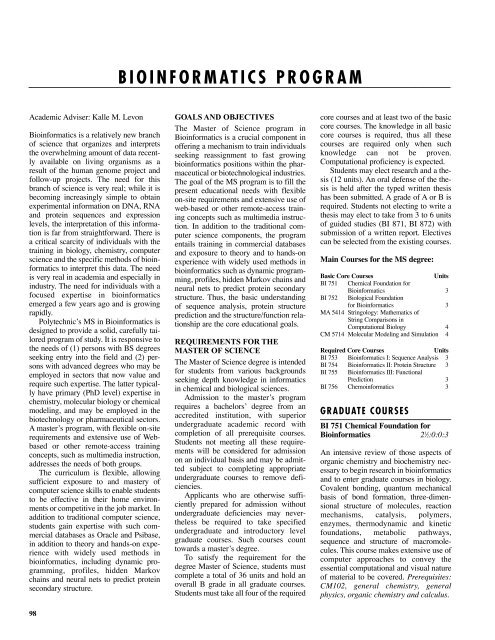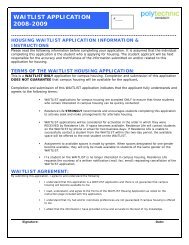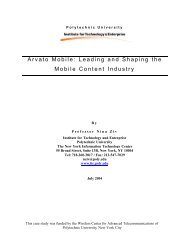POLYTECHNIC UNIVERSITY 2005-2007
POLYTECHNIC UNIVERSITY 2005-2007
POLYTECHNIC UNIVERSITY 2005-2007
Create successful ePaper yourself
Turn your PDF publications into a flip-book with our unique Google optimized e-Paper software.
BIOINFORMATICS PROGRAM<br />
Academic Adviser: Kalle M. Levon<br />
Bioinformatics is a relatively new branch<br />
of science that organizes and interprets<br />
the overwhelming amount of data recently<br />
available on living organisms as a<br />
result of the human genome project and<br />
follow-up projects. The need for this<br />
branch of science is very real; while it is<br />
becoming increasingly simple to obtain<br />
experimental information on DNA, RNA<br />
and protein sequences and expression<br />
levels, the interpretation of this information<br />
is far from straightforward. There is<br />
a critical scarcity of individuals with the<br />
training in biology, chemistry, computer<br />
science and the specific methods of bioinformatics<br />
to interpret this data. The need<br />
is very real in academia and especially in<br />
industry. The need for individuals with a<br />
focused expertise in bioinformatics<br />
emerged a few years ago and is growing<br />
rapidly.<br />
Polytechnic’s MS in Bioinformatics is<br />
designed to provide a solid, carefully tailored<br />
program of study. It is responsive to<br />
the needs of (1) persons with BS degrees<br />
seeking entry into the field and (2) persons<br />
with advanced degrees who may be<br />
employed in sectors that now value and<br />
require such expertise. The latter typically<br />
have primary (PhD level) expertise in<br />
chemistry, molecular biology or chemical<br />
modeling, and may be employed in the<br />
biotechnology or pharmaceutical sectors.<br />
A master’s program, with flexible on-site<br />
requirements and extensive use of Webbased<br />
or other remote-access training<br />
concepts, such as multimedia instruction,<br />
addresses the needs of both groups.<br />
The curriculum is flexible, allowing<br />
sufficient exposure to and mastery of<br />
computer science skills to enable students<br />
to be effective in their home environments<br />
or competitive in the job market. In<br />
addition to traditional computer science,<br />
students gain expertise with such commercial<br />
databases as Oracle and Psibase,<br />
in addition to theory and hands-on experience<br />
with widely used methods in<br />
bioinformatics, including dynamic programming,<br />
profiles, hidden Markov<br />
chains and neural nets to predict protein<br />
secondary structure.<br />
98<br />
GOALS AND OBJECTIVES<br />
The Master of Science program in<br />
Bioinformatics is a crucial component in<br />
offering a mechanism to train individuals<br />
seeking reassignment to fast growing<br />
bioinformatics positions within the pharmaceutical<br />
or biotechnological industries.<br />
The goal of the MS program is to fill the<br />
present educational needs with flexible<br />
on-site requirements and extensive use of<br />
web-based or other remote-access training<br />
concepts such as multimedia instruction.<br />
In addition to the traditional computer<br />
science components, the program<br />
entails training in commercial databases<br />
and exposure to theory and to hands-on<br />
experience with widely used methods in<br />
bioinformatics such as dynamic programming,<br />
profiles, hidden Markov chains and<br />
neural nets to predict protein secondary<br />
structure. Thus, the basic understanding<br />
of sequence analysis, protein structure<br />
prediction and the structure/function relationship<br />
are the core educational goals.<br />
REQUIREMENTS FOR THE<br />
MASTER OF SCIENCE<br />
The Master of Science degree is intended<br />
for students from various backgrounds<br />
seeking depth knowledge in informatics<br />
in chemical and biological sciences.<br />
Admission to the master’s program<br />
requires a bachelors’ degree from an<br />
accredited institution, with superior<br />
undergraduate academic record with<br />
completion of all prerequisite courses.<br />
Students not meeting all these requirements<br />
will be considered for admission<br />
on an individual basis and may be admitted<br />
subject to completing appropriate<br />
undergraduate courses to remove deficiencies.<br />
Applicants who are otherwise sufficiently<br />
prepared for admission without<br />
undergraduate deficiencies may nevertheless<br />
be required to take specified<br />
undergraduate and introductory level<br />
graduate courses. Such courses count<br />
towards a master’s degree.<br />
To satisfy the requirement for the<br />
degree Master of Science, students must<br />
complete a total of 36 units and hold an<br />
overall B grade in all graduate courses.<br />
Students must take all four of the required<br />
core courses and at least two of the basic<br />
core courses. The knowledge in all basic<br />
core courses is required, thus all these<br />
courses are required only when such<br />
knowledge can not be proven.<br />
Computational proficiency is expected.<br />
Students may elect research and a thesis<br />
(12 units). An oral defense of the thesis<br />
is held after the typed written thesis<br />
has been submitted. A grade of A or B is<br />
required. Students not electing to write a<br />
thesis may elect to take from 3 to 6 units<br />
of guided studies (BI 871, BI 872) with<br />
submission of a written report. Electives<br />
can be selected from the existing courses.<br />
Main Courses for the MS degree:<br />
Basic Core Courses<br />
Units<br />
BI 751 Chemical Foundation for<br />
Bioinformatics 3<br />
BI 752 Biological Foundation<br />
for Bioinformatics 3<br />
MA 5414 Stringology: Mathematics of<br />
String Comparisons in<br />
Computational Biology 4<br />
CM 5714 Molecular Modeling and Simulation 4<br />
Required Core Courses<br />
Units<br />
BI 753 Bioinformatics I: Sequence Analysis 3<br />
BI 754 Bioinformatics II: Protein Structure 3<br />
BI 755 Bioinformatics III: Functional<br />
Prediction 3<br />
BI 756 Chemoinformatics 3<br />
GRADUATE COURSES<br />
BI 751 Chemical Foundation for<br />
Bioinformatics 2 1 ⁄2:0:0:3<br />
An intensive review of those aspects of<br />
organic chemistry and biochemistry necessary<br />
to begin research in bioinformatics<br />
and to enter graduate courses in biology.<br />
Covalent bonding, quantum mechanical<br />
basis of bond formation, three-dimensional<br />
structure of molecules, reaction<br />
mechanisms, catalysis, polymers,<br />
enzymes, thermodynamic and kinetic<br />
foundations, metabolic pathways,<br />
sequence and structure of macromolecules.<br />
This course makes extensive use of<br />
computer approaches to convey the<br />
essential computational and visual nature<br />
of material to be covered. Prerequisites:<br />
CM102, general chemistry, general<br />
physics, organic chemistry and calculus.




